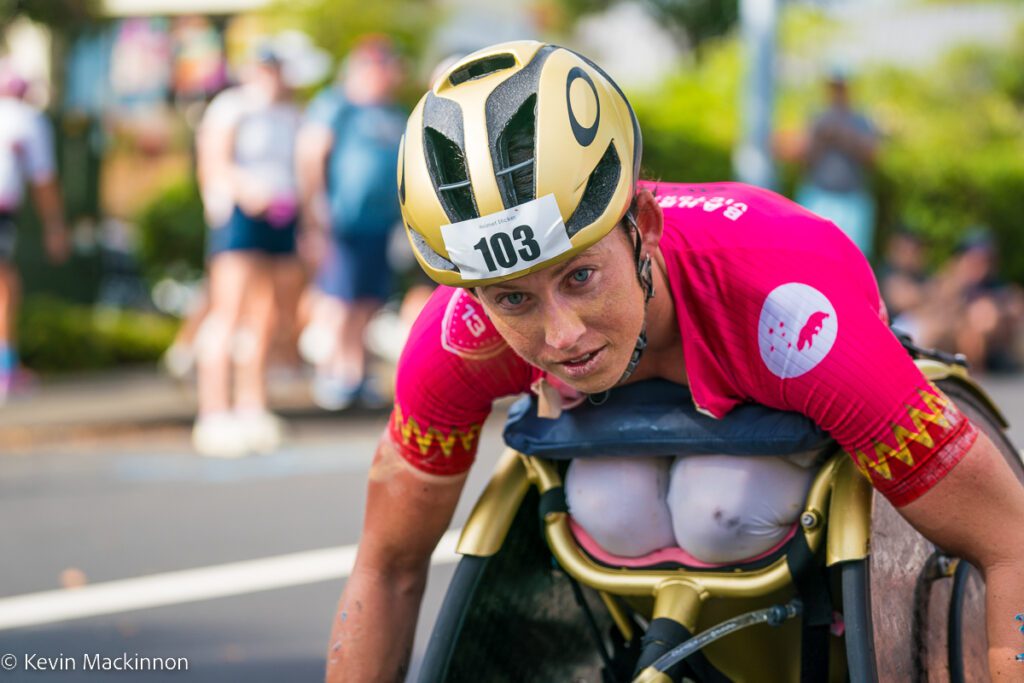Explaining Ironman’s Rule Changes for 2024 and how they’ll affect you
Turns out there aren't really many changes to the rules
 Photo by:
Kevin Mackinnon
Photo by:
Kevin Mackinnon
Last week we posted a story outlining the updates Ironman had made to its competition rules. We’ve since been given some specifics on the 2024 competition rules. Turns out that many of what we thought were changes were, in fact, clarifications of the existing rules.
Ironman updates competition rules – no more water bottles down shirts
You can see the complete 2023 to 2024 Rules Comparison below, but here are a few of the highlights:
- The zipper rule has been amended to reduce the severity of the penalty. Prior to this year the only option officials had was to disqualify an athlete who wasn’t able to “remedy” the situation promptly. That meant that officials had no choice but to disqualify Matt Sharpe after he crossed the finish line at Ironman 70.3 Maine last year with his zipper undone – he couldn’t “remedy” the situation as he’d already finished. “At the end of the day, the punishment doesn’t seem to fit the crime,” Sharpe said after the race. “The same punishment for that vs. taking outside assistance and repeated drafting seems harsh.” It would appear that Ironman officials agree with his assessment
- Turns out there’s no change to the rule or the penalty that states athletes can’t put a water bottle down their shirt for an aerodynamic benefit. Ironman has just added some verbiage to make things more clear: This includes, but is not limited to, (i) any bottles/hydration or any other insert located in the front of an athlete’s race suit and (ii) any insert in an athlete’s calf sleeves; (DSQ).
- When it comes to littering, Ironman hasn’t actually changed the rule from 2023, but has made it clearer that intentional littering will end up with a disqualification.
- In regards to fairings, tape and other wind-cheating devices, Ironman has amended its rules to be more in keeping with the World Triathlon rules. Ironman has made it clearer about where (and why) you can place tape on your bike. Covering the hole in a disc wheel? That’s fine. On your aero bars to cheat the wind? That’s not.

How the rule changes affect you.
- 2.05 (a): If you’re struggling to get to the finish line, now you just have to get to the “leading edge of the finish line gantry.” That still wouldn’t have helped Julie Moss win the Ironman World Championship in 1982, but it will no-doubt be of help to someone struggling to get to the finish line at some point this year.
- 4.01 (h): It’s now very clear what you can, and cannot, hang on to during the swim. Something that’s still is fair game. Something that’s moving forward – no go.
- That zipper rule? It doesn’t just help the Matt Sharpes of the world. Many age-group athletes have been disqualified for the same offence in year’s past. Now officials have another option. (They hated enforcing the DQ, too!)
- Trash rule? A no brainer. Leave the race course the same way you found it! Dispose stuff at aid stations.
- The water bottle down the shirt rule? We’re fans of getting rid of that trend, for sure.
- Fairings? World Triathlon seems to have done a good job with that rule, great that Ironman is following its lead.
- Mirrors and flags for handcycle competitors? Safety is good!
Here’s the update from Ironman with the rules comparison:
2023 to 2024 Rules Comparison
2.05 (a):
2023 Language: An athlete will be judged as finished the moment any part of his/her torso crosses a vertical line extending from the leading edge of the finish line;
2024 Language: An athlete will be judged as finished the moment any part of his/her torso crosses a vertical line extending from the leading edge of the finish line gantry;
Reason for change: Gantry language added to further clarify when an athlete is judged to have finished the event.
4.01 (h):
2023 Language: Any assistance during the swim will result in disqualification if forward progress was made. Athletes are permitted to use the on course kayaks and boats as aid, as long as no forward progress is made. Race Officials and medical personnel reserve the right to remove athletes from the course if such removal is determined medically necessary;
2024 Language: Any assistance during the swim will result in disqualification if forward progress was made. Athletes are permitted to use the on course kayaks, boats or any stationary floating rafts/docks as aid, as long as no forward progress is made. Race Officials and medical personnel reserve the right to remove athletes from the course if such removal is determined medically necessary;
Reason for change: Stationary floating rafts/docks language added to further clarify what an athlete is permitted to hold on to without risk of disqualification.
5.01(i) and 6.01(e):
2023 Language: Uniforms with a front zipper may be unzipped to any length, provided, that (i) the zipper should be connected at the bottom of the uniform at all times, and (ii) the top of the uniform should cover the shoulders at all times; (DSQ if not remedied promptly)
2024 Language: Uniforms with a front zipper may be unzipped to any length, provided, that (i) the zipper should be connected at the bottom of the uniform at all times, and (ii) the top of the uniform should cover the shoulders at all times; (30 or 60 Second Time Penalty (as applicable), DSQ if not remedied promptly)
Reason for change: Amended to reduce severity of penalty.
5.01(l) and 6.01 (f):
2023 Language: Any item that needs to be discarded, including but not limited to water bottles, gel wrappers, bar wrappers, broken bike parts, or clothing items, may be discarded only in the designated trash drop zones at each aid station. Discarding any item outside of the trash drop zones is prohibited; (5:00 Minute Time Penalty) *Please note: due to the local laws and ordinances at select Event venues, intentional littering will result in disqualification (See Event-specific Athlete Information Guide for more information).
2024 Language: Athletes shall not dispose of trash or equipment (including, but not limited to, water bottles, gel/bar wrappers, broken bike parts, clothing items, etc.) on the course except at aid stations or other designated trash-disposal points. Intentional or careless littering will result in a 5:00 Minute Time Penalty or disqualification. Please note: due to the local laws and ordinances at select Event venues, intentional littering will result in disqualification (See Event-specific Athlete Information Guide for more information).
Reason for change: No penalty change. Penalty emphasis for intentional or careless littering. Verbiage amended to clarify where athletes can dispose of trash or equipment.
5.01 (m):
2023 Language: Except as set forth below in Section 5.02(b), additional equipment that has the effect of reducing wind resistance is prohibited during the bike segment of the Race (whether such equipment is worn under the athlete’s clothing, over the athlete’s clothing, or is otherwise attached to the athlete’s body or the athlete’s bike); (DSQ) and
2024 Language: Except as set forth below in Section 5.02(b), additional equipment that has the effect of reducing wind resistance is prohibited during the bike segment of the Race (whether such equipment is worn under the athlete’s clothing, over the athlete’s clothing, or is otherwise attached to the athlete’s body or the athlete’s bike). This includes, but is not limited to, (i) any bottles/hydration or any other insert located in the front of an athlete’s race suit and (ii) any insert in an athlete’s calf sleeves; (DSQ)
Reason for change: No rule or penalty change. Verbiage added for further clarity.
5.03 (b):
2023 Language: Fairings are prohibited. Any device added or blended into the structure that may decrease, or that has the effect of decreasing, resistance to air penetration, or that may artificially accelerate propulsion, such as a protective screen, fuselage form fairing or the like, is prohibited; (DSQ)
2024 Language: Protective screens, fuselages, fairings, or any other devices or materials (including duct tape) added or blended into the structure with the intent to reduce (or having the effect of reducing) resistance to air penetration are prohibited. Aerodynamic assemblies and protuberances on the head tube or elsewhere are prohibited. Provided that the use of adhesive tape (including duct tape) does not fundamentally alter or enlarge the general shape of the structure, adhesive tape may be affixed to the bike (e.g., to cover valve cutout of the rear disc wheel, to cover bolts access, etc.); (DSQ)
Reason for change: No penalty change. Rule amended to be consistent with existing World Triathlon rules. Additional verbiage added to provide further clarity around use of adhesive tape.
For Reference, World Triathlon rule states: “Fairings are prohibited. Any device, added or blended into the structure, that is destined to decrease, or which has the effect of decreasing, resistance to air penetration or artificially to accelerate propulsion, such as a protective screen, fuselage form fairing or the like, shall be prohibited.
9.03:
Added language for 2024:
HC athletes must have a mirror fixed either to his/her helmet or at some point on the front of his/her handcycle to ensure rear-view vision is possible.
HC athletes must have a high visibility safety flag mounted to the rear of their handcycle. The top of the safety flag should measure a minimum of 1.8 meters/6 feet from the ground. The high visibility safety flag must be a minimum size of 21 centimeters/8 inches in height by 28 centimeters/10 inches in length.
HC athletes must have a red flashing light mounted to the rear of his/her handcycle, as well as a solid white light fixed to the front of his/her handcycle.
Reason for change: Added to increase athlete visibility. Rule also intended to further align with World Triathlon rules in relation to mirror use.
For Reference, World Triathlon rule states: “All handcycles must have a mirror fixed either to the athlete’s helmet or at some point on the front of the bike to ensure rear-view vision is possible.”
